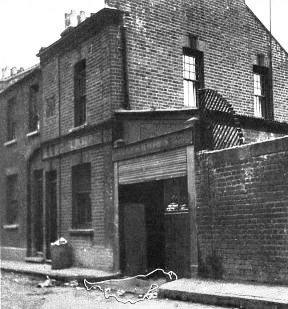Robert Paul was a 31-year-old carman – that is a delivery driver in today’s terms – who, at just before 3.45 on the morning of August the 31st 1888, left his home in Foster Street, in Whitechapel, to walk to his place of employment in Corbett’s Court, off Hanbury Street, in Spitalfields.
He proceeded in a southerly direction along Foster Street, turned right into Bath Street, made a left into Brady Street, and headed right along Buck’s Row, little realising that he was about to step into the saga of history’s most enduring mystery.
ROBERT PAUL AND BUCK’S ROW
Paul was very wary of Buck’s Row, as it had a terrible reputation as a location in which the local gangs were known to carry out robberies, often with violence, and, thus, no doubt, he wanted to get through the thoroughfare as quickly as he possibly could.
THE MAN IN THE ROAD
The first section of Buck’s Row as lined on its southern or left side by two storey cottages, and beyond them loomed the bulk of the Board School – building which still stands today, albeit it has now been converted into lats or apartments.
As he approached the Board School, he noticed a man standing in the roadway.
Paul was a little dubious of the man, and his unease grew stronger when the man came towards him.
Fearing that the stranger might be about to mug him, Robert Paul tried to go round him, but the man blocked his way and said, “come and look at this woman.”
THE WOMAN IN THE GATE
Looking at the gateway on the left side of the thoroughfare, Paul saw that their was a woman lying in it on her back.
The two went over and stooped down over the woman. The other man took hold of her hands, which, he said, were quite cold.
Robert Paul then reached out and placed his hand over her heart to see if he could detect any sign of life. He thought he felt a slight movement, and he told the other man that she might be breathing, and, therefore, still alive.
Paul then suggested that they should “prop her up”, that is sit her up in the gateway, but the other man demurred and said that he wasn’t going to touch her anymore.

THEY WENT FOR A POLICEMAN
They agreed that, since they were both ow running late for work, the best course would be to continue on their way and notify the first policeman that they came across that the woman was lying in the gate.
However, before they left, they attempted to pull the woman’s skirts, which were raised over her knees, down over her knees in order to cover their decency, a task which proved quite difficult.
Having done this, they then continued along Buck’s Row, turned into Baker’s Row at its other end, and here they found Constable Jonas Mizen who was on knocking up duty as part of his regular beat.
Having notified them of their discovery, they continued on their way, little realising that they had played a part in what would become the greatest mystery in history – for Mary Ann Nichols, the woman whose body they had discovered, is now widely regarded as the first victim of the killer we now know as Jack the Ripper.
CHARLES LECHMERE
Paul wouldn’t know the other man, and it would be a few days before he would learn that the man’s name was Charles Cross.
It would be an even greater amount of time before that man – who was referred to as Charles Cross throughout the subsequent inquest – was, in fact, Charles Lechmere, of 22 Doveton Street.
Since then, Lechmere has found his way onto the ever growing list of Jack the Ripper suspect’s, and there is a groundswell of opinion that maintains that Lechmere/Cross didn’t just find the body of Mary Nichols, but that he was the man who had carried out the murder.
